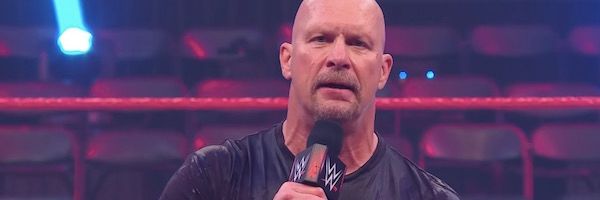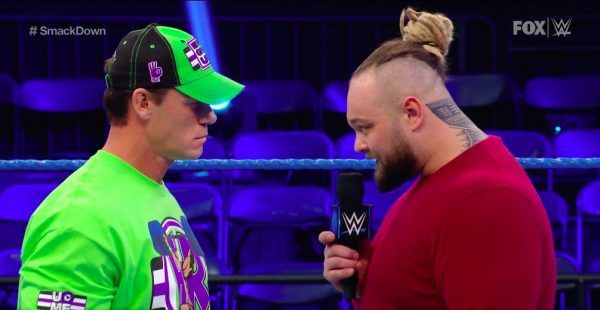The spread of the coronavirus has hit the entertainment business like a bomb, closing theaters and halting productions worldwide. But there is also no form of entertainment more attached to the "show must go on" mantra than professional wrestling, that traveling circus of tights and testosterone that kept on trucking through 9/11, Jerry Lawler's on-air heart attack, and the actual in-ring death of Owen Hart in 1999. In this specific case, both the WWE and fledgling federation AEW have navigated the coronavirus by putting on shows in empty buildings, the performers locking up and promo-ing to empty seats. The experience has been surreal, occasionally uncomfortable, and, more than anything, it's been illuminating. Never has the melodramatic heart that makes professional wrestling tick been so plain to see.
As an art form—which wrestling absolutely is, despite its permanent place at the bottom of the Taste Totem Pole—pro wrestling's symbiotic relationship with its live audience is unique. Spectators at a wrestling show aren't just there to watch, they're an active part of the performance. A scripted sport barely works without a crowd willing to lose its mind over the result; it's a key part of the illusion, integral to suspending your disbelief. A horror movie without the soundtrack is just someone walking down a dimly-lit hallway, ya know? It's generally agreed-upon that loudest "pop" in pro wrestling history happened in 1999, when "Stone Cold" Steve Austin helped Mankind win the WWE Championship from Dwayne "The Rock" Johnson. Watch it below, take in the sound of a few thousand people collectively attaining a higher form of existence at the sound of shattering glass, and then imagine how goddamn silly this entire scene would play out in silence.
Or, you know, don't imagine it, because it's kind of been playing out on TV for the past few weeks. As of this writing, we've gotten one WWE Smackdown, one WWE Raw, and one AEW Dynamite from a completely empty building, all happening under the shadow of the announcement that WrestleMania—WWE's massive five-hours-plus extravaganza that usually attracts a few hundred-thousand spectators—would be split into two nights and filmed in the company's performance center, sans crowd. WrestleMania is the epitome of what capital-letter Pro Wrestling is, in the sense that it's borderline obnoxiously large, unabashedly operatic, and objectively extra as fuck. The coronavirus-mandated empty arena shows have forced pro wrestling to head in the opposite direction and think much, much smaller.
As for as the in-ring product goes, that direction has been...weird. It's weird! The literal physical act of pro wrestling is just very, very weird when conducted in total silence. Something you can't quite appreciate unless you've been to a smaller live show is how damn loud the ring itself is, thanks to the medieval combination of nuts, springs, and plywood inside of it. Then there's the audible grunts, the lack of reaction to athletic displays, and the WWE's extremely odd decision to still have its performers play to the "crowd". The ladies and gents of WWE and AEW are some of the most gifted athletes on the planet, but remove that crucial crowd-interaction puzzle piece and you're just a few steps away from watching an Olympic-level gymnastics practice. An impressive exercise in going through the motions.
But what's been genuinely surprising is the effect that same silence has on the storytelling aspect of these shows. Pro wrestling has always been a mad mix-up of a carnival and a stage play, a Tenessee Williams melodrama that ends with someone falling off a ladder through a table. That required its stories to be told as loudly and broadly as possible, broadcasted to the people in the cheap seats. But without an audience, these larger-than-life personality clashes have the option to speak a bit more softly. It's like watching the Avengers have a particularly intense game of gin rummy with Thanos instead of fighting him in outer space.
The best example happened on Smackdown, in a confrontation between John Cena and Bray Wyatt, two characters who are objectively ridiculous. John Cena is a walking Saturday morning cartoon PSA who already has one foot firmly planted in Hollywood. Bray Wyatt is a former swamp-dwelling cult leader who now hosts a terrifying children's show that may or may not take place entirely in his own mind. Watching these two men commit to this bit in total silence is an entirely new level of performance art, a mix of intensity and the absurd that wouldn't feel too out of place in a David Lynch movie.
Over at AEW, the most recent episode of Dynamite ended with the surprise debut of Matt Hardy, a longtime WWE star making the jump between companies. Hardy's whole schtick is kind of impossible to sum up but imagine like, purposefully terrible soap opera acting meets an obscure late-90s X-Men character. It's a lot. He has a pet drone named Vanguard 1. It's all very strange, but fans eat it up because it's endearingly strange. Fans validate the absurdity. Now watch Hardy make his debut in silence, and more importantly, watch every other performer have to sell that debut to silence. It's high-class clownery. The theater of the absurd.
When these empty-arena attempts don't quite work, they still round back to become the kind of ultra-surreal anti-comedy that Eric Andre or Tim & Eric have been debuting around 4 am on Adult Swim for years. I still legitimately don't know what vibe WWE was going for with the now-viral segment that saw "Stone Cold" Steve Austin trying to hype up a row of empty chairs. But I do know that A) It was one of the strangest, most uncomfortably bizarre things I've seen on TV in years, and B) I could not tear my eyes away from it if I tried. It was the type of niche-oddness only pro wrestling could provide.
When you try and explain why you love a certain kind of entertainment, you have to boil it down to whatever sits at the center. That's really the result of these empty-arena shows, a version of pro wrestling that's just an endearingly bizarre melodrama carried out by cartoon characters with six-packs. The crowds will (hopefully) return one day and turn the show back into a spectacle, but for now, it's kind of fascinating to wrestle with all that silence.


